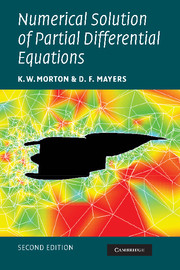Book contents
- Frontmatter
- Contents
- Preface to the first edition
- Preface to the second edition
- 1 Introduction
- 2 Parabolic equations in one space variable
- 3 2-D and 3-D parabolic equations
- 4 Hyperbolic equations in one space dimension
- 5 Consistency, convergence and stability
- 6 Linear second order elliptic equations in two dimensions
- 7 Iterative solution of linear algebraic equations
- References
- Index
- Numerical Solution of Partial Differential Equations
Preface to the second edition
Published online by Cambridge University Press: 05 September 2012
- Frontmatter
- Contents
- Preface to the first edition
- Preface to the second edition
- 1 Introduction
- 2 Parabolic equations in one space variable
- 3 2-D and 3-D parabolic equations
- 4 Hyperbolic equations in one space dimension
- 5 Consistency, convergence and stability
- 6 Linear second order elliptic equations in two dimensions
- 7 Iterative solution of linear algebraic equations
- References
- Index
- Numerical Solution of Partial Differential Equations
Summary
In the ten years since the first edition of this book was published, the numerical solution of PDEs has moved forward in many ways. But when we sought views on the main changes that should be made for this second edition, the general response was that we should not change the main thrust of the book or make very substantial changes. We therefore aimed to limit ourselves to adding no more than 10%–20% of new material and removing rather little of the original text: in the event, the book has increased by some 23%.
Finite difference methods remain the starting point for introducing most people to the solution of PDEs, both theoretically and as a tool for solving practical problems. So they still form the core of the book. But of course finite element methods dominate the elliptic equation scene, and finite volume methods are the preferred approach to the approximation of many hyperbolic problems. Moreover, the latter formulation also forms a valuable bridge between the two main methodologies. Thus we have introduced a new section on this topic in Chapter 4; and this has also enabled us to reinterpret standard difference schemes such as the Lax–Wendroff method and the box scheme in this way, and hence for example show how they are simply extended to nonuniform meshes.
- Type
- Chapter
- Information
- Numerical Solution of Partial Differential EquationsAn Introduction, pp. xi - xivPublisher: Cambridge University PressPrint publication year: 2005



